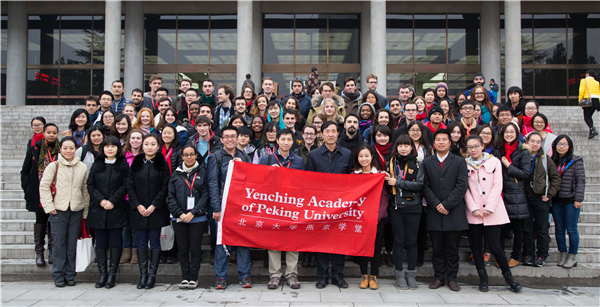This November, Yenching Academy's inaugural class of 96 students from 39 countries traveled to Xi'an, formerly known as Chang'an, for a week-long field study experience. There, they encountered a city both ancient and modern.

In bustling downtown Xi’an, signs for designer clothing line the streets, and people happily gab as they munch on every kind of snack. There is a flurry of noise and activity. Amid this modern urban scene, the lights of the Ming Dynasty Bell and Drum Towers glimmer red and green among the shopping malls, their sight reminding visitors of this city’s long and magnificent history as the capital of ten dynasties. The two towers in the heart of the modern city serve as reminders that this place’s present is deeply intertwined with its past.
Built in the 1380s, the Bell and Drum Towers are actually young compared to many of the city’s other renowned historic sites. In Xi’an, the Yenching Scholars were immersed in on-site history lessons drawing them back over 2,000 years, to China’s first unified Dynasty.
During their first full day in Xi’an, students viewed the terracotta warriors of Emperor Qinshihuang, China’s first emperor. They were able to see firsthand the full-size statues of these warriors, each individualized, with its own facial features and hairstyle. As they toured the pits, they listened to tour guides using sound-receiving devices and earphones specially prepared by the Academy. They learned about how each piece was formed and then assembled, and how every craftsman was held responsible for the quality of his work, with the threat of capital punishment serving as quality control. These on-site explanations helped them to better understand the complexities of the Emperor who commissioned the warriors—a man admired for unifying China, unifying writing, and unifying measures, while at the same time known for his cruelty and severity.
“I consider it to be a unique experience to have been able to appreciate with my own eyes the magnificent historical heritage of the terracotta warriors, which show the greatness of the Empire,” said Yenching scholar Héctor Zavala from Mexico. “This field study experience helped me to better understand Chinese history and culture and provided an opportunity to get to know the lifestyle of former Chinese civilizations regarding food, clothing, entertainment, architecture and other fields of study."
The scholars’ sound-receiving devices aided them in understanding not only the Qin Mausoleum site, but also the Hanyangling Mausoleum, the Forest of Stone Steles Museum, the Shaanxi History Museum, and other sites. Listening through their earphones, the students could concretely experience historical sites and view ancient relics while enjoying commentary by Peking University Professor of History Lu Yang, as well as local experts.
Traveling to the Qin Tombs, Han Tombs, Tang Dynasty Dayan Tower, and the Ming Dynasty Daming Palace sequentially, the students were able to develop a sense of time’s passage as they moved between the ancient relics of these dynasties, gradually drawing nearer to the present day. This transition toward the present was also reflected in students’ living arrangements, as they moved from the suburbs of Xi’an to the heart of the modern city midway through the week. Living downtown gave students an opportunity to experience contemporary aspects of the city, such as touring the Muslim Street near the Bell and Drum Towers, where they could sample many local treats. There they watched as vendors made nut crisps by pounding oversized hammers, and made candy by slinging and twisting sugary concoctions into their final shapes. The vendors’ work served as performance art in addition to providing sustenance for the hungry scholars.
“I can best describe Muslim Street as the Silk Road come to life in the 21st Century,” said Yenching scholar Mary Schulman from the United States. “It was remarkably vibrant and diverse, with all different people coming together —Chinese people, Middle-Eastern people, Turkish people—and the food was amazing! With the neon lights and vibrant atmosphere, Muslim Street was a unique experience that complemented our visits to historical sites very well."
Near the modern city center, students also had the opportunity to bike city wall constructed around the capital city of Chang’an, during the Ming Dynasty. The two-hour bike ride offered students a unique opportunity to spatially contextualize the scale of the former capital, and to see how it had transformed to become part of present-day Xi’an
From watching traditional Shaanxi shadow puppetry to touring ancient mausoleums; from enjoying a musical performance at the Guanzhong Folk Museum to biking the Ming Dynasty city wall; Yenching Academy’s field study experience in Xi’an allowed students to learn in a place where the ancient and the modern intermingle. It allowed them to personally gain a sense of China’s dynamic changes and long history; to transition between ancient tombs and vibrant street life; to view a modern city from a centuries-old vantage point, and an ancient past through a modern lens.


“Each site brought to life a different period of Chinese history,” Schulman said. “That was the most significant part of the experience for me. We got to transition from the Qin Dynasty to the Han to the golden age of the Tang Dynasty to Ming. It was amazing to see firsthand all of these places that I had read and learned about before.”
